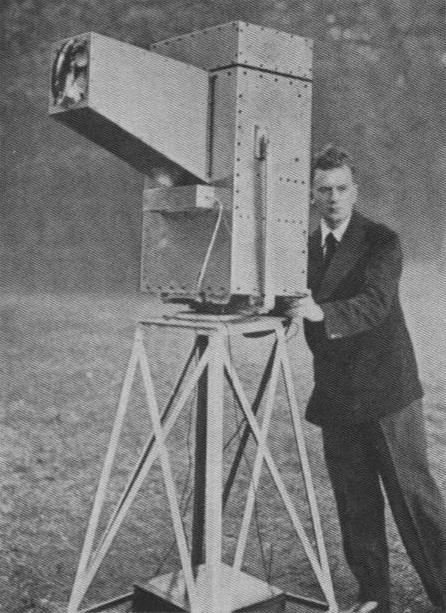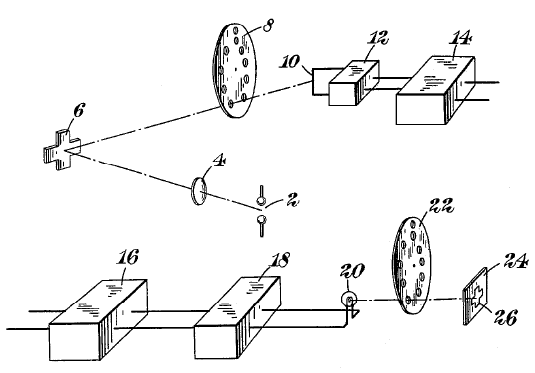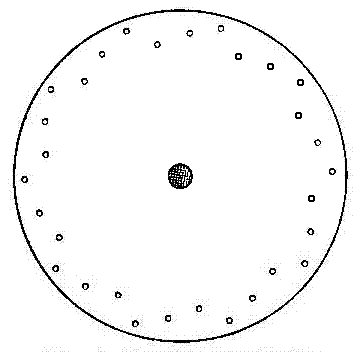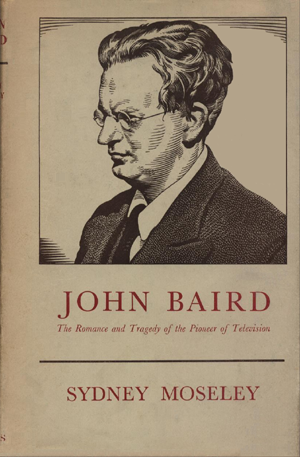Baird's Radar SecretBreathless Web sites proclaim that the British military is now disgorging "top secret" files! Some of these files date all the way back to World War II. Surely some of this data must concern the famous inventor John Logie Baird. All through the war, he operated a small electronics laboratory in Sydenham. Maybe we'll learn if Baird contributed to the war effort. Then after many decades, we'll at last know the "truth" about Baird's secret invention "noctovision." Was the mysterious noctovision really a top secret? Could it really see through the dark and clouds? Might it be radar? Well, these are the popular claims. They smell a bit like snake oil, but they sure sell books. As to the secrecy: Gosh, folks, nobody has yet found any "secret" files. Somewhat unusually for a "top secret" gadget, noctovision is a publicly patented and demonstrated machine. Accounts from its own time mainly stress its novelty. Did the news quickly fade due to some conspiracy? Let's apply Occam's Razor to this conspiracy theory. A more plausible reason for the news fadeout occurs to us: Noctovision operated poorly, and didn't attract a following. As for the noctovision hoopla, it seems more recent. We can assume that this recent excitement is either revisionist thinking or publicity. But the plot thickens. Just what was noctovision, anyway? Was it radar? What do the experts say? |

Not Radar: Baird and his ship-borne noctovisor [Dinsdale, facing p. 60] |
|
|
|
What is noctovision?
Noctovision with infrared
Seeing lights through fog. We know that John Baird, borrowing profusely from the work of Ernst Ruhmer, demonstrated noctovision. Noctovision was mechanical television that operated with infrared light instead of visible light. Not much new there. Yet Baird, ever the promoter, asserted that noctovision could see through some types of fog. Some of Baird's patents even explored the idea of using noctovision for navigation. Baird's navigational noctovision was a camera and a monitor all in one package. With noctovision, a ship at sea could receive a low-resolution image of a lighthouse lamp. One ship might also spot the navigation beacon of another ship, and then avoid a collision.[Moseley and Barton-Chapple, pp. 129-131]
Low resolution.The navigational noctovisor also included a compass-like dial. By aiming the noctovisor lens, the operator could read the bearing to the distant light. The lens angle helped the operator to determine the elevation of the remote subject.[Moseley and Barton-Chapple, p. 132] Yet despite its bearing and elevation finding capabilities, the noctovisor couldn't compute the distance to an object. The promised fog penetration also turned out to be a fantasy. Noctovision simply couldn't penetrate all types of fog. Moreover, the machine's hyper-low resolution was a serious limitation. Important image details might well fall between the noctovisor's 30 scan lines. Because of the lacking definition, noctovision's angle of view was extremely narrow. While the device could locate distant lights, it couldn't detect the contours of a treacherous coastline. (This fact indicates that noctovision would have been useless as a night scope. The night scope claim, another misconception about noctovision, appears elsewhere on the Web.)
Noctovision with radio
In some patents, Baird surmises that noctovision's illumination source could be radio waves. The usual citation refers to British patent #292,185. (Baird also filed a similar American patent, #1,699,270.) In the American patent, Baird speculates throughout. He supposes that near-infrared radio waves (microwaves, perhaps?) could penetrate fog more readily than could infrared.[Baird, lines 32-35] In other words, Baird admits a fundamental defect in infrared noctovision. He then suggests improving noctovision by substituting very short radio waves for infrared.
|
Patent flaws. According to noctovisor patent art[Baird, figure], the radio waves emanate from a spark gap. Baird shows this spark gap (2) as an illuminant. The patent includes no tank circuit for tuning the spark gap into resonance. The electrode gap itself must then provide tuning. Or more likely, no reliable tuning is possible. The output signal would then likely be a broadband, non-resonant signal. (The broadband output is typical of spark transmitters. Actually, whether CW or damped waves feed the gap is difficult to say.) The patent confirms this point by proposing a “lens” to filter spark gap waves. Baird also hypothesizes that as these waves penetrate fog, the fog becomes a secondary filter. The fog would only pass useful frequencies. (This idea assumes much: That useful frequencies exist and are sufficiently strong.) Note the curious pitch (tar) lens (4) before the gap. This lens seems to be a throwback to infrared noctovisor days. (In those days, the gap would have been a very similar arc lamp.) |

Block diagram of noctovision [from U.S. Patent 1,699,270, p. 1]. Top row: Transmitter, 2 through 8. Receiver, 10 through 14. Bottom row: Receiver (continued), 16 through 26. |
Filter. The reader must wonder if a lens could actually focus radio waves. Other examples of pitch lenses for microwaves exist. For instance, some automotive radar detectors employ similar plastic lenses. According to the patent, the pitch lens doesn't magnify or concentrate, as with a glass lens for light. Instead, the pitch lens is a type of filter that passes only the desired microwaves.[Baird, lines 51-61] (By the way, Baird didn't invent the pitch lens.)
Disc. The patented version of noctovision still scans the subject (6) with a disc: The disc (8) that Baird copied from Paul Nipkow's patent. Normally, this disc would scan a field of light from an arc lamp. Baird assumes that this same disc can now scan a field of broadband radio waves. This is a very dubious idea. Each frequency of waves has a different focal point. Some frequencies might even penetrate the solid parts of the disc. As wave frequencies rise or fall, the disc apertures and disc material require adjustments. We know this to be true, because cameras focus at a different point with infrared than with visible light. The patent's disc description doesn't account for differences in light and radio waves.
The Noctovision receiver consists of these parts...
| 10—Antenna | 16—Wired/wireless connection | 22—Nipkow disc |
| 12—Detector | 18—Amplifier | 24—Screen |
| 14—Amplifier | 20—Moore glow lamp | 26—Image |
Patents
Antennas. As we've seen, Baird's block diagram for Patent 292,185 is quite vague. This diagram includes only a rudimentary antenna (10). We assume a fixed, wire antenna, instead of dishes as many modern radars use. Baird's antenna is a throwback to Tesla, Hertz and Marconi. Probably the spark generator operates on the microwave band. Hertz conducted experiments on this band.
No modulation. The illumination source is also unmodulated. For this reason, engineers have pointed out that Baird's invention couldn't determine range to a target. Baird's son Malcolm proposes adding such modulation. But of course, a patent is what it is. An inventor can't claim rights to "what might have been." That's the difference between a patent and blind faith.
Was it radar?
Incredulous. Elsewhere on the Web, you'll find incredulous accounts that link radio-noctovision and radar. Some Web pages don't stop there, but insist that "Baird must have invented radar!" The expert sources below explain why these ideas are false. (Two of these sources are British.)
What do the experts say?
Moseley. The first source is Sydney Moseley, John Logie Baird's closest and most loyal friend. Moseley publicized Baird's achievements and later wrote an authoritative Baird biography. Moseley was also the financial wizard that saved Baird's first company. Moseley inteviewed two distinguished engineers who both participated in the development of radar. Both of these men knew Baird and his work.
Burns. Our second source is Russell Burns, who wrote a very detailed technical history of Baird's work. Burns' style is accessible to both technical and lay readers. The quality of the writing and research are excellent. Burns' earlier work also details much of Baird's history.
Abramson. Albert Abramson's first McFarland book is one of the top research sources for television history. Abramson also worked in the television industry. He gathered his facts during extensive, worldwide travels and investigation of original documents. Interviews with many original television engineers supplemented Abramson's literary research. Abramson's history books are among the most objective and least biased toward one inventor.
Dunlap. Orrin Dunlap is one of the great technical writers and technical historians of the twentieth century. As early television developed, Dunlap was there. He wrote many of the first television articles for the New York Times. Some of these groundbreaking articles appear in the anthology The Outlook for Television. Dunlap was a tireless student and biographer of the sciences, particularly radio. His Radio's 100 Men of Science is a treasure. Its concise, yet understanding account summarizes contributions from scientists across the world.
...Sir Robert clearly saw no connexion between Noctovision and radar and I must therefore acccept Professor [Edward V.] Appleton's positive assurance that the two inventions were in no way allied.
Burns
Below is what author, historian and engineer Russell Burns says about Baird and radar. [Burns, p. 119. See bibliography, below.]
Noctovision vs. Radar
In these applications Baird used unmodulated infra-red rays: there is no evidence that he modulated by any means the source of the infra-red radiation. Consequently he could not determine the distance of an object from the infra-red transmitter. This is an important point since it has been argued—quite strongly and extensively—that Baird's noctovisor was a type of radar and that ipso facto Baird was a radar pioneer. The argument is false.
Radar is an acronym for RAdio Detection And Ranging. Distance measurement of a target/object is a characteristic of all radars with the exception of Doppler radars, which measure a target's radial velocity towards a transmitter. It is impractical to determine the distance (d) of a target from a radiator when continuous electromagnetic waves (of wavelength λ) are employed (excluding the trivial case where d < λ). For unambiguous target/object range measurement the transmitted radiation must be modulated, for example pulse modulated or frequency modulated. If a continuous wave source were used, distance measurement would be ambiguous and in error by nl, where n is, in practical cases, an exceedingly large and unknown integer 15.
Radar is not the same as television. The former technology (excluding Doppler radar) gives the position coordinates (in three dimensions) of an object; the latter technology displays in two dimensions a three-dimensional scene. Stereoscopic television can give an illusion of depth in a scene but it does not provide information about the distances from a datum of the objects which constitute the scene.
Abramson
Television historian Albert Abramson also weighed in on noctovision. [Abramson, p. 105. See bibliography, below.]
Problems with Noctovision
On September 5, 1927, at the annual meeting of the British Association for the Advancement of Science, J.L. Baird demonstrated his newest system of television, called Noctovision. ...the subject sat in darkness and was subjected to a powerful beam of infrared radiation. This eliminates the bright lights but creates problems due to the special response of the infrared as compared to daylight. This demonstration was not very successful, with quite a bit of flicker and apparent fading of the picture.
Dunlap
Orrin Dunlap exposes the make-believe conflict over who invented radar. Hint: The "who" isn't "Baird." [Dunlap, p. 123. See bibliography, below.]
Who Invented Radar?
Who invented radar? Who was its Faraday or Maxwell; who its Marconi or Edison?
Characteristic of all major advances in radio, radar with its sleepless, X-ray eyes was no overnight development of an individual. As the automobile took the wheels of the wagon and the body of the carriage, so radar is built upon the electronic devices and techniques of radio. In its evolution it drew upon all the past of radio science and electronics. It is the timely assembly of ideas and inventions of many men, as was the wireless of Marconi. Radar dramatically reveals how necessity is the mother of invention.
Dr. A. Hoyt Taylor, chief consultant and chief co-ordinator for electronics at the Naval Research Laboratory and a "father" of radar told newsmen that radar was not an "invention." He explained that "it is a development, just as broadcasting is a development in which thousands of people have played their parts. And as one of my British friends remarked to me, there is plenty of credit in radar to go around."
Could the experts be missing something?
Speculation isn't proof. Sure, our experts could be missing something. But we reject the notion that "late-breaking Baird news is about to arrive." That's another promotional gimmick to help sell a book. Fact: After all these decades, the news trail is ice cold. Since 1946, Baird has been pushing up daisies. Let him rest in peace. Besides, speculation isn't proof. And a fable, no matter how compelling, isn't proof. And faith, though it may be blind, isn't proof, either. Without proof, what's the sense in crediting Baird with an achievement? Anyway, the so-called "evidence" that we've already seen is defective. We've just proven that it's defective. Why should we now expect anything but more of the same?
Conclusion
Let's cast off the sensationalism. Underneath it, we discover that Baird didn't invent radar. No one person did or could have. Radar is a compound invention. It's the research, inspiration and development of many people. Further, as experts testify, Baird's unmarketed invention noctovision simply isn't radar.
References
Abramson, Albert. The History of Television: 1880 to 1941. Jefferson, North Carolina: McFarland & Company, Inc., Publishers, 1987.
Baird, John. 2005. Apparatus for transmitting views or images to a distance. U.S. Patent 1,699,270, filed May 4, 1928 and issued January 15, 1929.
Burns, Russell. John Logie Baird. N.c.: The Institution of Engineering and Technology, 2001.
Dinsdale, Alfred. First Principles of Television. Arno Press, 1975. (Reprint. Original publication: London: Chapman & Hall, Ltd., 1932.)
Dunlap, Orrin E. Radar: What Radar is and How it Works, Revised Edition. New York: Harper and Brothers, 1948.
Moseley, Sydney Alexander. John Baird, The Romance and Tragedy of the Pioneer of Television. London: Odhams Press, 1952.
Moseley, Sydney and H.J. Barton-Chapple. Television To-Day and To-Morrow London: Sir Isaac Pitman & Sons, Ltd, 1933.
Go to Page: 1 2 3 4 5 Next
PAGE CONTENTS
- Baird's Radar Secret
- What is Noctovision?
- Noctovision with infrared
- The noctovision disc
- Noctovision with radio
- Patents
- Was it radar?
- What do the experts say?
- Moseley
- Burns
- Abramson
- Dunlap
- Could the experts be missing something?
- Conclusion
- References

